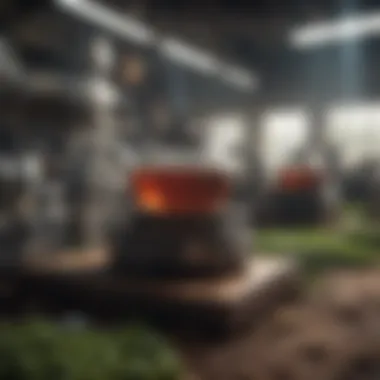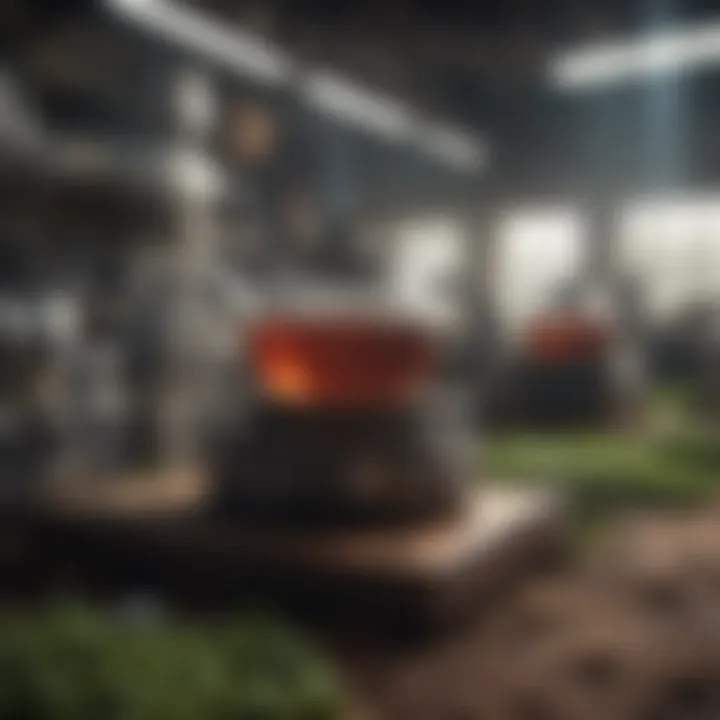Exploring the Complexities of Tea Production


Intro
Tea production is not a mere commercial activity; it is a blend of art, culture, and science. As we embark on this exploration, we will dissect the complexities involved in every stage of tea's journey from leaf to cup. The understanding of these intricacies is crucial for anyone who consumes tea or works within its industry. We will delve into various aspects of tea, from how it is cultivated and processed to the economic, cultural, and health implications of this ancient beverage.
In the subsequent sections, we will uncover how environmental factors and traditional methods intertwine to shape the flavor profiles of different teas. Additionally, we will address the impact of tea production on local economies and ecosystems. Finally, we will highlight the health benefits associated with tea, supported by scientific studies and current trends.
Foreword to Tea Production
The realm of tea production represents a tapestry of cultural, economic, and environmental intricacies. Understanding the foundations of this field is essential for anyone engaged in the trade or study of tea. Much more than a mere beverage, tea serves as a cultural artifact and an economic staple for many regions around the world.
To appreciate the global significance of tea, one must analyze its historical context and the practices that define its cultivation. Key elements include the biodiversity of the tea plant, the geographic factors influencing growth, and the techniques that determine quality. As we delve deeper, the importance of terroir will emerge, influencing not just the flavor profile but also the market value of different tea varieties.
Moreover, tea's production evolves continuously, facing challenges tied to climate change, shifting consumer preferences, and economic fluctuations. Therefore, it is important to recognize not only the processes involved but also the implications of tea production on local economies and global markets. This article aims to untangle these complexities, offering a lens through which to view tea as both a product and a significant facet of human culture.
Historical Context of Tea
Tea has a rich history that dates back thousands of years, with its origins traced back to ancient China. Initially, tea was used primarily for medicinal purposes before evolving into a popular drink among nobles and later, the general population. The legend of Emperor Shen Nong discovering tea in 2737 BC illustrates the beverage's deep cultural roots and its transformation over the centuries.
The trade of tea expanded significantly during the Tang dynasty (618-907 AD) and continued to flourish during the Song dynasty (960-1279 AD), leading to a desire for the beverage across Asia and eventually the world. European traders, drawn to tea's flavorful profile, began importing it in the 17th century, with places like England and the Netherlands playing pivotal roles in its spread.
"Tea is the magic elixir that binds societies across the globe, rooted in tradition yet evolving with each generation."
"Tea is the magic elixir that binds societies across the globe, rooted in tradition yet evolving with each generation."
Today, tea is entrenched in many cultural practices around the world, from Japanese tea ceremonies to British afternoon tea. Understanding its historical progression provides insights into its current status as a global commodity, shaping both cultural narratives and economic practices.
Global Overview of Tea Cultivation
The cultivation of tea is a global endeavor, with major producers including China, India, Kenya, and Sri Lanka. Each region approaches tea farming with unique methods and traditions, influenced by local climates and soil conditions. For instance, the Darjeeling region in India is well-known for its distinct flavor profiles, frequently referred to as the 'Champagne of teas.' In contrast, Chinese tea cultivation boasts a variety of practices stretching from traditional to modern agricultural techniques.
Tea plants thrive under specific climatic conditions, requiring adequate rainfall, warmth, and altitude. The interaction between these factors and the various tea plant species results in significant differences in taste, aroma, and quality.
As global demand for tea continues to rise, growers are adopting sustainable practices to maintain their yields while minimizing environmental impact. Climate change poses challenges such as disease outbreaks and shifting weather patterns, which necessitate adaptive strategies among tea farmers worldwide.
Furthermore, emerging markets in the tea sector are unveiling new opportunities and challenges, impacting not only production techniques but also trade relations. A comprehensive understanding of these factors is crucial for stakeholders aiming to navigate the complexities inherent in tea production.
Cultivation of Tea
Cultivating tea is an essential aspect of the entire tea production process. The growth environment directly affects the quality, flavor, and characteristics of the tea produced. Understanding tea cultivation is crucial for anyone involved in the tea industry, from farmers to consumers. It encompasses multiple factors including climate, soil preparation, and the selection of plant varieties.
Climate Requirements for Tea Growth
Tea plants flourish in specific climatic conditions. Generally, they prefer areas with warm temperatures and ample rainfall. The optimal temperature ranges between 20°C and 30°C. Regions with high humidity also support tea growth, often leading to richer flavors. The ideal rainfall is about 1,200 to 2,000 millimeters annually. Moreover, it is important for this rain to be evenly distributed throughout the year. Any significant deviation from these conditions can affect the yield and quality.
Tea plants are sensitive to frost, with cold temperatures hindering their growth. Therefore, it is common to find tea plantations in regions with misty mountains that provide both warmth and moisture. Adequate shade is also important, as too much direct sunlight can be detrimental during certain growth stages.
Soil Characteristics and Preparation
Soil plays a fundamental role in the health and productivity of tea plants. The ideal soil for tea cultivation is acidic, with a pH level between 4.5 and 6.0. Well-drained soils are preferred, as they prevent waterlogging that can lead to root diseases. Good drainage and aeration enhance root development and nutrient uptake.
Before planting, soil preparation is crucial. This often involves clearing land, tilling, and enriching the soil with organic matter. Organic compost helps improve soil structure and provides essential nutrients. Farmers also conduct soil tests to determine nutrient levels and identify deficiencies. Addressing these deficiencies effectively sets the stage for a robust tea crop.
Plant Varieties and Their Distinctions
Different varieties of tea plants exhibit distinct characteristics. The two main species are Camellia sinensis and Camellia assamica. Camellia sinensis is traditionally cultivated for green and black teas. In contrast, Camellia assamica is used primarily for stronger teas, such as Assam.
Within these species, there are numerous cultivars developed for various climates and consumer preferences. For instance, the Darjeeling variety is famous for its delicate aroma, while the Nilgiri variety is known for its briskness. Selecting the right cultivar is crucial for achieving desired flavor profiles and adapting to specific growing conditions.
"The diversity in tea plant varieties allows for a broad spectrum of flavors and aromas, making tea cultivation both an art and a science."
"The diversity in tea plant varieties allows for a broad spectrum of flavors and aromas, making tea cultivation both an art and a science."
In summary, the cultivation of tea involves careful consideration of climate, soil, and plant variety selection. Each aspect plays a vital role in determining the quality of the final product. Understanding these elements can lead to better practices in tea production, fostering improved outcomes for producers and consumers alike.
Harvesting Techniques


Harvesting techniques are critically important to tea production. The way tea leaves are harvested can significantly influence the quality, yield, and flavor of the final product. It shapes not only the economic viability for tea producers but also the sensory characteristics that consumers experience. Understanding the nuances of both manual and mechanical harvesting provides deeper insights into the complexities of tea production.
Manual vs. Mechanical Harvesting
Manual harvesting is a time-tested method where skilled workers handpick tender tea leaves. This traditional technique often results in superior quality leaves since pickers can choose only the best parts of the plant. Additionally, manual harvesting allows for selective picking, which helps in maintaining the overall health of the tea bushes. By focusing on specific leaves, workers can encourage optimal growth for future harvests.
However, manual labor can be costly and time-consuming. Factors such as labor availability and wages also play an important role in this method’s viability. In contrast, mechanical harvesting utilizes machines to collect tea leaves. This method greatly increases efficiency and reduces labor costs, making it appealing for larger estates.
Despite its advantages, mechanical harvesting has limitations. Machines tend to harvest a mix of younger leaves and older, tougher foliage. This may result in lower-quality tea. Additionally, not all tea cultivation environments are suitable for mechanical methods.
Both methods require careful planning and consideration. The choice depends on the specific conditions of the tea plantation, the desired quality of the tea, and the economic context of production.
Timing and Conditions for Optimal Harvesting
Timing is a crucial element in tea harvesting. The ideal time to harvest depends on several factors, including weather conditions, moisture content, and seasonal growth cycles. The best quality tea generally comes from leaves that are harvested in the morning when moisture levels are still high.
Tea plants have distinct growth periods when leaves are at their peak flavor. Understanding these cycles is essential for maximizing quality. Besides timing, understanding the broader environmental conditions can impact the decision about when to harvest.
"Optimal harvesting aligns with both the growth cycle of the tea plant and external environmental conditions to yield the best quality tea."
"Optimal harvesting aligns with both the growth cycle of the tea plant and external environmental conditions to yield the best quality tea."
Processing Methods
Processing methods are crucial in tea production as they largely determine the final flavor profile, aroma, and quality of the tea. After harvesting, tea leaves undergo various procedures to transform them into the beverages enjoyed worldwide. These methods not only affect taste but also the chemical composition of the tea, impacting its health benefits. Understanding the processing techniques is essential for anyone interested in the complexities of tea production, from producers to consumers.
Withering and Oxidation
Withering is often the first step in processing tea leaves. During this stage, freshly harvested leaves lose moisture and start to soften. This process makes the leaves more pliable for rolling. Environmental factors, such as humidity and temperature, play a significant role. The goal is to reduce moisture content to around 60% to prepare the leaves for oxidation.
Oxidation, or fermentation, follows the withering process. This is where the leaves undergo chemical changes due to exposure to air. Different types of tea require varying levels of oxidation. For instance, black tea is fully oxidized, which darkens its color and enhances its flavor. Conversely, green tea is minimally oxidized, preserving a more delicate taste. Factors such as time and temperature must be controlled carefully to achieve the desired degree of oxidation.
"The balance of withering and oxidation sets the stage for the final profile of the tea."
"The balance of withering and oxidation sets the stage for the final profile of the tea."
Rolling Techniques and Their Impact
Rolling is an essential step that impacts the release of essential oils and enzymes critical for flavor development. This can be done manually or mechanically. The purpose is to break down the leaf structure, facilitating oxidation while enhancing essential oils’ exposure to air. Different tea types require varying rolling techniques.
For example, oolong tea is rolled into tight balls, allowing for a unique flavor profile development. Meanwhile, some green teas are left unrolled to maintain a lighter flavor. The impact of rolling on flavor can be profound, making this step a significant consideration in tea processing.
Key aspects to consider with rolling techniques include:
- Type of tea: The desired characteristics dictate the rolling method.
- Consistency of the leaves: Evenly rolled leaves ensure uniform oxidation and flavor.
- Expertise of the processor: Skilled artisans can significantly enhance tea quality through their technique.
Drying Methods: Conventional vs. Innovative
The final drying stage aims to halt oxidation and preserve the aroma and flavor. Two main drying methods exist: conventional and innovative. Conventional methods often involve sun drying or using hot air. These have been used for centuries and ensure all moisture is removed and flavors are locked in.
Innovative methods are emerging, such as freeze-drying or infrared drying, which promise to preserve the essential compounds while maintaining flavor integrity. Each method brings its own benefits and challenges. For instance:
- Conventional drying tends to be more economical but may affect flavor complexity.
- Innovative drying can be more expensive and requires specialized equipment but often results in superior quality tea.
Quality Control in Tea Production
Quality control in tea production is essential for ensuring that the final product meets consumer expectations. The intricate nature of tea, with its diverse flavors and characteristics, demands a rigorous quality assurance process. By focusing on key aspects such as standards, certifications, and sensory evaluation, producers can maintain high-quality products that resonate with both local and global markets.
The importance of quality control extends beyond mere consumer satisfaction. High standards in tea production can lead to increased marketability and higher prices. It fosters consumer trust in brands and enhances the industry’s reputation overall. Additionally, effective quality control can help identify and mitigate issues before they escalate, ensuring continuity in production and supply.
Standards and Certifications in Tea Quality
Establishing rigorous standards and certifications is critical for maintaining tea quality. Various organizations, such as the International Organization for Standardization (ISO) and the Rainforest Alliance, set guidelines that producers must follow. These standards cover numerous aspects, including production practices, handling, and storage of tea.
Key points regarding these standards include:
- Regulatory compliance: Adhering to national and international regulations helps producers avoid legal issues and ensures that their products are safe for consumption.
- Quality benchmarks: Standards provide benchmarks for evaluating tea quality, allowing for consistency across different batches and regions.
- Sustainability focus: Many modern standards emphasize the importance of sustainable farming practices, promoting environmental stewardship in tea cultivation.
- Consumer confidence: Certifications act as a seal of approval for consumers, fostering trust in the product's quality and sourcing.


Incorporating these standards into production not only elevates the quality of tea but also enhances its market appeal.
Sensory Evaluation Techniques
Sensory evaluation is a vital component of quality control in tea production. It involves the systematic assessment of the tea’s appearance, aroma, taste, and feel. This comprehensive method allows producers to understand consumer preferences and identify any inconsistencies in the product.
Common sensory evaluation techniques include:
- Triangle tests: This method presents tasters with three samples, two of which are identical. Evaluators must identify the differing sample, thus providing insight into subtle flavor variations.
- Descriptive analysis: Trained panels assess various attributes of tea, such as aroma intensity or mouthfeel, using standardized vocabulary.
- Consumer testing: Gathering feedback from everyday consumers helps producers understand preferences and fine-tune their products accordingly.
Sensory evaluation not only helps in maintaining quality but also drives innovation in flavor profiles and blends.
Sensory evaluation not only helps in maintaining quality but also drives innovation in flavor profiles and blends.
These techniques assist in upholding high-quality standards and provide feedback essential for refining production processes. By prioritizing sensory evaluation, producers can better align their products with market demands.
Economic Aspects of Tea Production
Tea production plays a crucial role in the global economy, impacting both local and international markets. As one of the most consumed beverages worldwide, it contributes significantly to the livelihoods of millions of people. This section focuses on the economic aspects of tea production, shedding light on its market dynamics, trade patterns, and fair trade practices.
Market Dynamics and Global Trade
The market for tea is multifaceted, influenced by several factors including supply and demand, production costs, and consumer preferences. The global tea market has seen a steady increase in demand driven by health consciousness and a penchant for premium products. Key producing countries include China, India, and Kenya, each with unique advantages that affect pricing and supply.
Factors such as climate change pose risks to tea production, impacting yields in various regions. The global trade of tea is also affected by trade agreements and tariffs, which can either facilitate or hinder market access for producers. As a product traditionally linked to commodity markets, tea’s prices can be volatile, influenced by fluctuating demand and contributions from emerging markets.
Key Points in Market Dynamics:
- Consumer Preference: Growing interest in specialty teas.
- Pricing Volatility: Fluctuations due to external factors such as climate.
- Emerging Markets: Countries like Vietnam and Sri Lanka becoming significant players.
"The tea industry is not just about cultivation; it also involves trade relations, economic policies, and consumer trends that shape its future."
"The tea industry is not just about cultivation; it also involves trade relations, economic policies, and consumer trends that shape its future."
Fair Trade Practices and Their Impact
Fair trade has become an essential concept in the tea industry, aiming to promote ethical production practices and ensure fair wages for producers. By cutting out middlemen, fair trade practices ensure that farmers receive a higher share of the profits. This is especially crucial in developing countries where many tea workers face economic challenges.
Implementing fair trade certification standards encourages sustainable farming and community development. Products labeled as fair trade often fetch higher prices in retail markets. This can motivate producers to adopt better practices, improving both the quality of tea and environmental sustainability.
In essence, fair trade initiatives lead to:
- Improved Living Standards: Fair wages help uplift communities.
- Sustainable Practices: Encouraging organic farming methods.
- Market Access: Opening doors for small-scale producers.
The economic implications of these fair trade practices highlight the growing importance of ethical considerations in consumer choices and their capacity to drive change in production methods worldwide.
Environmental Impact of Tea Cultivation
Understanding the environmental impact of tea cultivation is crucial for several reasons. First, tea is one of the most widely consumed beverages in the world. This demand pressures ecosystems and habitats. Therefore, assessments help ensure that tea production is sustainable, fostering practices that minimize damage to the environment. Furthermore, the agricultural techniques used can contribute both positively and negatively to local ecosystems.
Sustainable Practices in Tea Farming
Sustainable practices in tea farming are vital to mitigate negative environmental impacts. These include agroforestry, organic farming, and integrated pest management. Agroforestry involves planting tea alongside other crops, which can improve both biodiversity and soil health. This practice also provides farmers with alternative sources of income, diversifying their economic risks.
Other sustainable techniques include avoiding synthetic fertilizers and pesticides. Organic farming methods promote soil fertility and protect local fauna. Farmers can utilize natural pest control methods that do not harm beneficial insects. This reduces the reliance on harmful chemicals and preserves the natural ecosystem.
"Adopting sustainable practices not only benefits the environment but also enhances the quality of the tea itself, creating a win-win scenario for producers and consumers alike.”
"Adopting sustainable practices not only benefits the environment but also enhances the quality of the tea itself, creating a win-win scenario for producers and consumers alike.”
Biodiversity and Ecosystem Effects
Tea cultivation can significantly affect biodiversity. Large-scale plantations can lead to monoculture, where only one type of plant is grown. This practice diminishes habitat availability for various species, leading to a decline in local biodiversity. Moreover, the clearing of land for tea plantations can disrupt ecosystems, affecting soil health, water retention, and local wildlife.
However, when tea is cultivated responsibly, it can support biodiversity. Mixed cropping and preserving native vegetation around tea farms can help create a balanced ecosystem. Efforts to protect endangered species and promote ecological corridors can improve resilience against climate change.


In addition to supporting wildlife, healthy ecosystems contribute to better tea production. They help maintain the nutrient cycles necessary for plant growth and pest management. Ultimately, mindful tea farming balances productivity with ecological sustainability.
Cultural Significance of Tea
Tea carries a deep and intricate cultural significance around the globe. It serves not only as a beverage but also as a symbol of hospitality, tradition, and community. Tea's role extends beyond mere consumption; it acts as a medium through which societal values and customs are transmitted. The various ways in which tea is integrated into daily life and special occasions reveals much about the cultural identities of different regions.
Among many cultures, tea ceremonies represent an important ritual, encapsulating values like respect and mindfulness. These ceremonies often require specific rituals and a deep understanding of the process, turning the act of drinking tea into an art form. This enhances the social fabric as it brings people together and fosters connections. The significance of tea is evident in how diverse cultures have adapted its preparation and consumption to reflect local customs and beliefs.
"Tea is the magic elixir that can turn an ordinary moment into an extraordinary experience of connection and reflection."
"Tea is the magic elixir that can turn an ordinary moment into an extraordinary experience of connection and reflection."
In the context of an ever-globalizing world, tea has maintained its relevance, finding its way into various social contexts and modern-day practices.
Traditional Tea Ceremonies Across Cultures
Traditional tea ceremonies exist in various forms and hold unique meanings across cultures. In Japan, the tea ceremony, or "Chanoyu," is a ritualistic practice that emphasizes aesthetics and the philosophy of harmony. Participants engage in the meticulous preparation and serving of matcha, a powdered green tea. This practice is not just about taste; it represents principles of Zen Buddhism, such as simplicity and mindfulness.
In contrast, the Chinese tea ceremony, known as "Gongfu Cha," focuses on the skillful brewing of tea. It involves precision and care in each step, showcasing a variety of teas and their unique qualities. The ceremony is steeped in history and is often accompanied by stories or poetry, creating a rich context for appreciation.
In other regions like the Middle East, tea plays a role in hospitality. Countries like Morocco often have elaborate mint tea rituals that symbolize welcome and generosity. Tea is served in ornate glasses, and the process itself—from boiling the water to pouring it at various heights—transforms an everyday act into a ceremonial gesture.
Tea and Social Rituals
Beyond formal ceremonies, tea is interwoven into daily and social rituals. In many cultures, drinking tea is a social practice that fosters communication and connection. For instance, in British culture, afternoon tea offers a dedicated time for social interactions, often accompanied by pastries and small sandwiches. It is a time to unwind and share moments with family and friends.
In India, chaiwala stalls create an informal gathering space where locals congregate. Here, the act of sharing a cup of tea transcends class and social barriers, making it a communal experience.
Across numerous cultures, tea brings people together, serving as a medium through which relationships are built and nurtured. The shared experience of consuming tea allows individuals to bond, discuss matters, and celebrate life’s moments, whether joyous or somber.
Health Benefits of Tea
The exploration of tea production extends beyond the processes involved; it leads us to significant findings regarding health benefits associated with tea consumption. Tea has long been valued not only for its aroma and flavor but also for its potential health attributes. The health benefits of tea are diverse, encompassing various aspects of well-being, making this topic crucial for anyone interested in the multifaceted nature of tea.
Nutritional Components of Tea
Tea is rich in a variety of nutritional components that contribute to its health-promoting properties. The primary constituents include antioxidants, particularly polyphenols, which are known for combating oxidative stress in the body. Among these, catechins have gained attention for their potential effects on heart health and metabolic rate.
In addition to polyphenols, tea also contains vitamins and minerals, such as vitamin C, manganese, and potassium.
The nutritional profiles can vary significantly depending on the type of tea. For instance, green tea is known for its high levels of epigallocatechin gallate (EGCG), which has been linked to numerous health benefits. Black tea, on the other hand, contains flavonoids that may support cardiovascular health. Consider the following:
- Antioxidants: Protect cells from damage.
- Vitamins: Support overall health and immune function.
- Minerals: Contribute to various bodily functions.
Scientific Studies on Health Effects
A multitude of scientific studies have investigated the health effects of tea. Research indicates that regular tea consumption may lower the risk of chronic diseases such as heart disease, type 2 diabetes, and certain cancers. For example, meta-analyses have shown a correlation between consuming green tea and a reduced risk of cardiovascular issues. These studies suggest that the bioactive compounds in tea may enhance blood vessel function and reduce inflammation.
Moreover, some studies focus on the cognitive benefits of tea. Regular tea drinkers may experience improved mental clarity and a lowered risk of cognitive decline as they age.
In summary, the health benefits of tea are backed by nutritional components and scientific research. However, as with any dietary consideration, moderation and personal health context are vital. Integrating tea into one’s diet can be a simple yet effective way to promote overall health.
Future Trends in Tea Production
Future trends in tea production represent a crucial aspect of the evolving landscape of the industry. As tea is not just a beverage but a cultural symbol and economic powerhouse, understanding these trends can significantly enhance both production methods and consumer satisfaction. This section sheds light on how technological innovation and shifts in consumer preferences play a pivotal role in shaping the future of tea production.
Technological Innovations in Tea Processing
Technological advancements are transforming the way tea is produced and processed. Innovations such as automated sorting and quality grading systems enhance efficiency and consistency. These technologies help producers meet the rising demand for high-quality tea in global markets. The integration of data analytics also allows tea producers to monitor plant health and optimize growth conditions in real-time, thus minimizing risks related to climate fluctuations.
This enhances not only productivity but also reduces waste. For example, some producers are using precision agriculture techniques, which involve using sensors and drones to gather data on soil health and moisture levels. This information helps farmers apply resources more effectively.
Furthermore, innovations in tea extraction techniques lead to new products enriched with distinct flavors and health benefits. Companies are increasingly investing in research to develop tea blends that cater to specific health objectives such as detoxification or relaxation. The collaboration between agriculture scientists and tea producers is essential in this innovative approach, ensuring that both quality and sustainability are prioritized.
Emerging Markets and Consumer Preferences
The dynamics of tea consumption are shifting, with emerging markets gaining prominence. Countries such as China and India are not only leaders in production but also in consumption, developing unique tastes and preferences. For instance, the younger generation is increasingly looking for products that align with health consciousness, sustainability, and premium quality. Organic and specialty teas are experiencing a surge in demand, as consumers are willing to pay more for products that present a mix of quality and ethical production.
Social media also plays a significant role in shaping consumer preferences. Platforms like Reddit and Facebook are being used by brands to directly engage with their audience and educate them about different types of teas and brewing methods. This direct consumer engagement fuels trends, leading manufacturers to adapt swiftly to market demands. Moreover, awareness regarding environmental issues has sparked interest in sustainable farming practices, reflecting a broader global shift towards ethical consumption.
"The future of tea production will be defined by innovation and consumer engagement, as producers adapt to a rapidly changing world."
"The future of tea production will be defined by innovation and consumer engagement, as producers adapt to a rapidly changing world."



